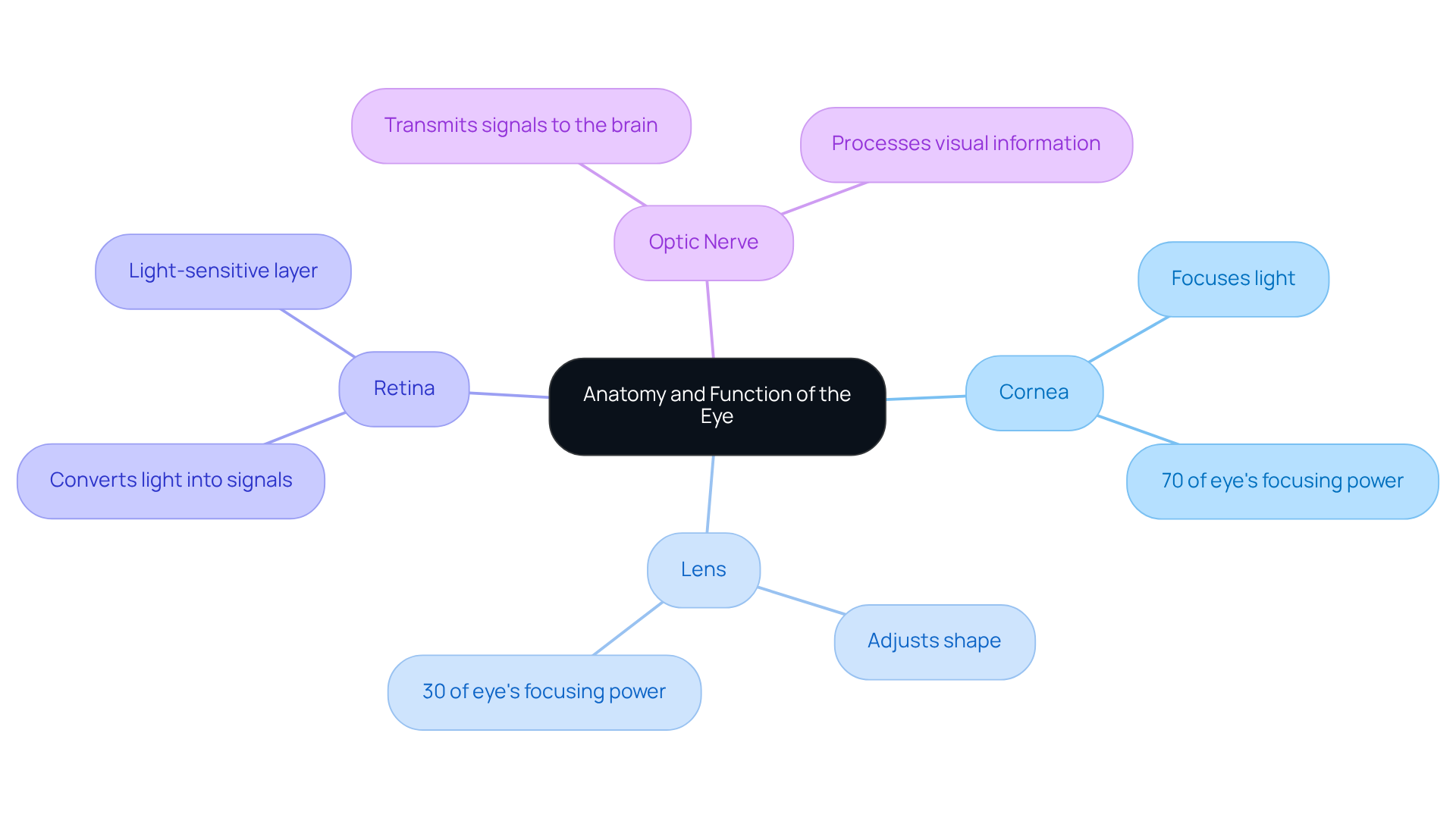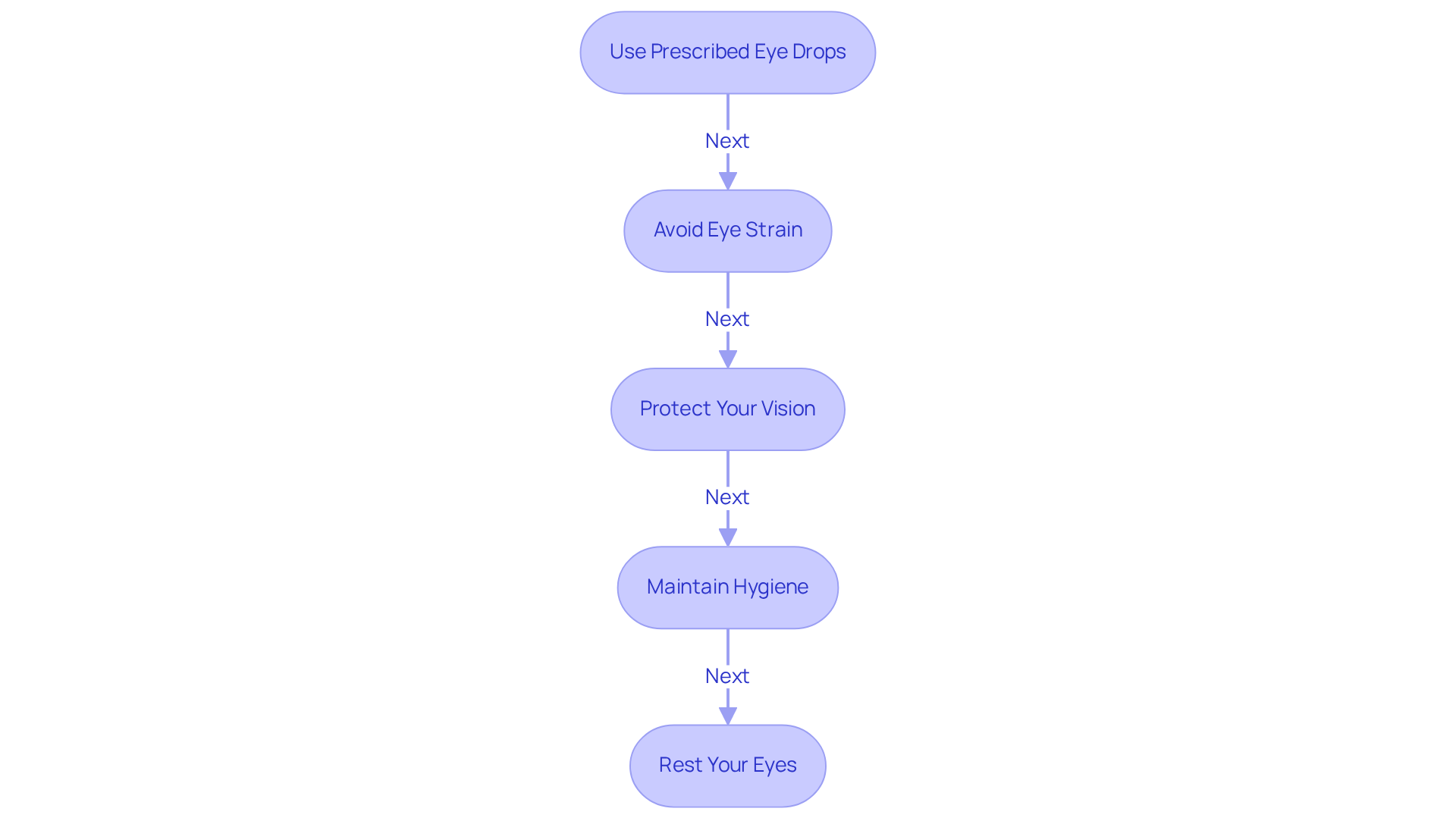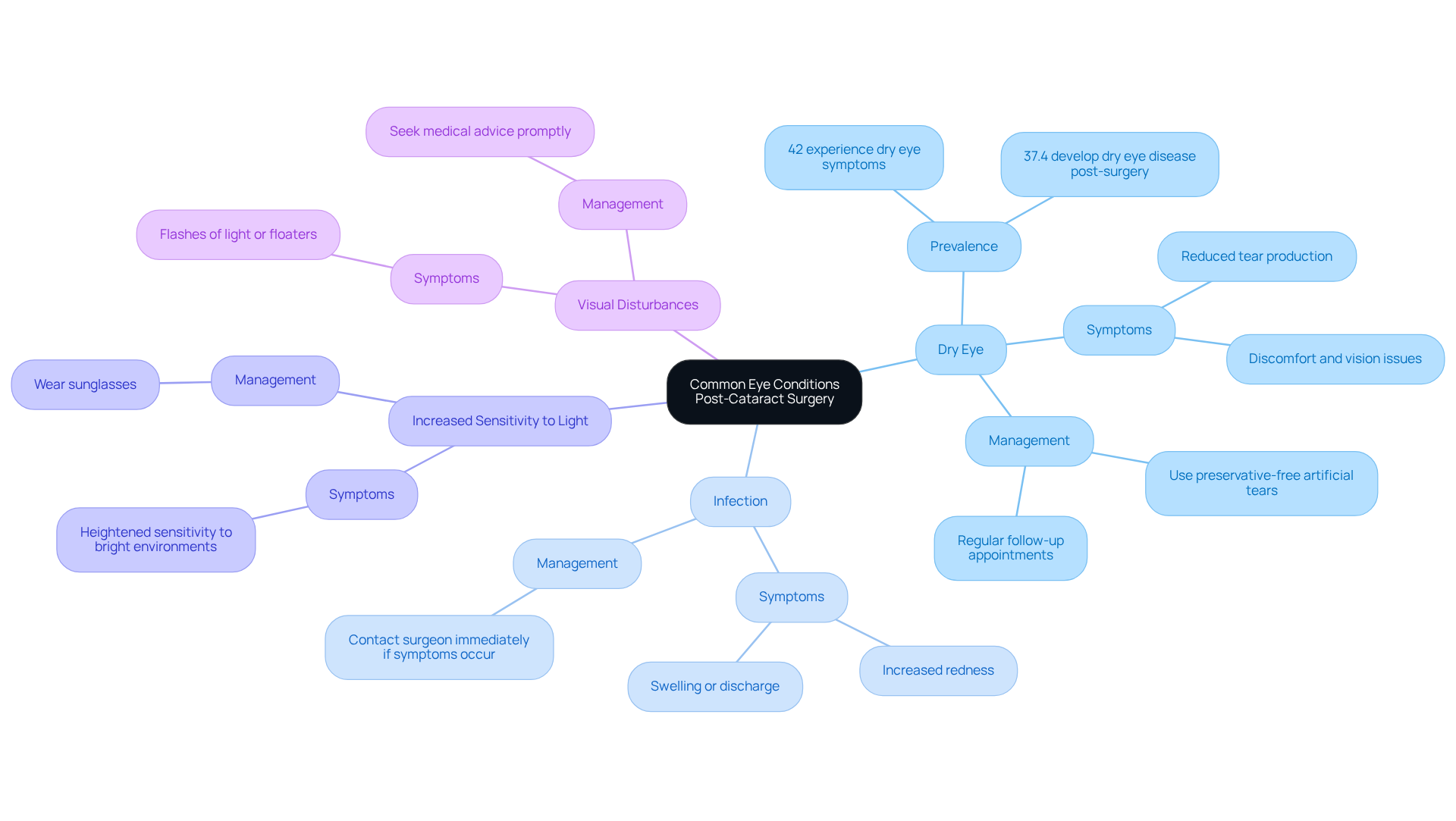Posted by: Northwest Eye in General on August 3, 2025
Overview
Caring for your eyes after cataract surgery is crucial, and we understand that you may have concerns during this recovery process. Here are three essential steps to help you care for your eyes:
-
Use prescribed eye drops: These drops are vital for your healing, and following this recommendation can significantly enhance your recovery.
-
Avoid eye strain: It’s common to feel discomfort, so take breaks and give your eyes the rest they need.
-
Protect your vision from harmful elements: Shielding your eyes from bright lights and dust is essential in preventing complications.
Expert advice strongly supports these recommendations, emphasizing that adhering to post-surgical care routines can lead to better recovery outcomes and minimize potential issues like infections and dry eye symptoms. Remember, we are here to help you through this process, and following these steps can make a significant difference in your healing journey.
Introduction
Cataract surgery can be a transformative experience, offering you the promise of clearer vision and a renewed quality of life. We understand that the journey to optimal recovery requires diligent care and a grasp of the eye’s intricate anatomy and functions. In this article, we delve into essential steps for post-surgery eye care, highlighting daily routines and common complications that may arise.
It’s common to feel a mix of emotions during this critical phase, and the question remains: how can you ensure a smooth recovery while safeguarding your vision against potential pitfalls? We are here to help you through this process.
Understand the Anatomy and Function of Your Eyes
The human eye balls are complex organs made up of several parts, each of which plays a vital role in vision. We understand that learning about these components can be overwhelming, but it’s important to know how they work together to support your sight. Key components include:
- Cornea: The clear front layer that helps focus light.
- Lens: Located behind the iris, it adjusts shape to focus light onto the retina, much like how eye balls help in focusing images.
- Retina: The light-sensitive layer at the back of the eye balls that converts light into signals sent to the brain.
- Optic Nerve: Transmits visual information from the retina to the brain, processing signals received from the eye balls.
Grasping these elements allows you to appreciate how lens replacement can enhance your vision by substituting the opaque lens with a transparent artificial one. We know that can also assist you in monitoring your recovery and identifying any unusual symptoms that may arise. Remember, we are here to help you through this process, and it’s common to have questions as you navigate your journey to better vision.

Implement Daily Eye Care Routines
To care for your eyes after cataract surgery, we understand how important it is to follow these essential daily routines:
- Use Prescribed Eye Drops: Following your surgeon’s instructions regarding antibiotic and anti-inflammatory eye drops is vital. These medications are crucial for preventing infection and minimizing inflammation. As noted by Grace Zhang, MD, “After cataract surgery, it’s crucial to adhere to various guidelines, such as using eye protection and prescribed eye drops to aid in healing.” It’s common to feel overwhelmed by the costs associated with recovery; statistics indicate that 88% of Medicare beneficiaries prescribed postoperative eye drops incurred significant expenses, with brand medications accounting for 76.5% of these costs. This underscores the importance of adhering to prescribed treatments to ensure effective recovery and improve the value of care delivered to Medicare beneficiaries, as emphasized by Sidra Zafar.
- Avoid Eye Strain: We understand that adjusting to life after surgery can be challenging. To help, limit your screen time and practice the 20-20-20 rule: every 20 minutes, look at something 20 feet away for 20 seconds. This simple practice can help reduce eye fatigue and promote healing.
- Protect Your Vision: It’s essential to guard your sight from harmful UV rays and dust. Wear sunglasses outdoors, and consider using an eye shield while sleeping for the first week to , which can lead to complications.
- Maintain Hygiene: We care about your well-being, so always wash your hands before touching your face or applying eye drops. Avoid getting soap or water directly in your eyes during showers to prevent irritation or infection.
- Rest Your Eyes: Ensure you get plenty of sleep and avoid strenuous activities that could strain your eyes, such as heavy lifting or vigorous exercise. Following these guidelines is essential for a smooth recovery and optimal healing.
As noted by eye care professionals, adhering to these routines significantly enhances recovery outcomes and minimizes the risk of complications. Proper use of prescribed eye drops is particularly emphasized, as they play a critical role in the care of eye balls during post-surgical recovery. Remember, we are here to help you through this process.

Recognize and Manage Common Eye Conditions
After cataract surgery, we understand how important it is to be vigilant about several common eye conditions:
- Dry Eye: Many patients experience dry eye due to reduced tear production, which can affect both comfort and vision. To alleviate discomfort, we recommend using preservative-free artificial tears as directed by your ophthalmologist. It’s common to hear that approximately 42% of patients notice dry eye symptoms within the first week post-surgery, with severity typically peaking around this time. Notably, the combined prevalence of dry eye disease following lens replacement is reported as 37.4%, highlighting the significance of this condition.
- Infection: It’s essential to be alert for signs of infection, such as increased redness, swelling, or discharge from the eye balls. If you notice any of these symptoms, please contact your surgeon immediately. While are generally low, specific studies indicate that they can occur, making prompt action crucial for effective management.
- Increased Sensitivity to Light: It’s common to feel heightened sensitivity to light after surgery. Wearing sunglasses can help manage this discomfort and protect your eye balls from bright environments. As noted by ophthalmologists, this symptom is a typical postoperative experience that should be monitored.
- Visual Disturbances: If you notice sudden changes in vision, including flashes of light or floaters, it’s important to address these promptly. Seeking medical advice can help, as these symptoms may indicate complications that require attention.
Regular follow-up appointments with your ophthalmologist are vital for monitoring your recovery and addressing any concerns that may arise. We are here to help you through this process, ensuring that any potential issues are managed effectively, contributing to a smoother recovery journey.

Conclusion
Caring for your eyes after cataract surgery is essential for ensuring a successful recovery and maintaining optimal vision. We understand that this can be a daunting time, but by grasping the intricate anatomy of the eye and implementing effective daily care routines, you can significantly enhance your healing process. It’s important to adhere to prescribed treatments, protect your eyes from strain and environmental hazards, and recognize potential complications. This proactive approach underscores the importance of diligent eye care.
Key strategies to consider include:
- The proper use of prescribed eye drops
- The significance of rest and hygiene
- The necessity of monitoring for common post-surgical conditions such as dry eye and infection
Each of these elements plays a critical role in safeguarding your eye health and facilitating a smooth recovery journey. Engaging with your healthcare professionals and staying informed about potential symptoms can further empower you to take charge of your post-operative care.
In light of these insights, we encourage anyone undergoing cataract surgery to prioritize their eye care routines and remain vigilant about their recovery. Embracing these practices not only promotes healing but also enhances your overall quality of life. Taking the time to understand and implement these guidelines can lead to a brighter, clearer future, reinforcing the significance of diligent eye care in your daily life.
Frequently Asked Questions
What are the main components of the human eye?
The main components of the human eye include the cornea, lens, retina, and optic nerve.
What is the function of the cornea?
The cornea is the clear front layer of the eye that helps to focus light.
How does the lens contribute to vision?
The lens, located behind the iris, adjusts its shape to focus light onto the retina, similar to how eye balls help in focusing images.
What role does the retina play in vision?
The retina is the light-sensitive layer at the back of the eye that converts light into signals that are sent to the brain.
What is the function of the optic nerve?
The optic nerve transmits visual information from the retina to the brain, processing the signals received from the eye.
How can understanding the anatomy of the eye help with vision problems?
Understanding the structure of the eye can assist in monitoring recovery from eye procedures and identifying any unusual symptoms that may arise.
What is lens replacement and how does it enhance vision?
Lens replacement involves substituting an opaque lens with a transparent artificial one, which can enhance vision by improving focus.






